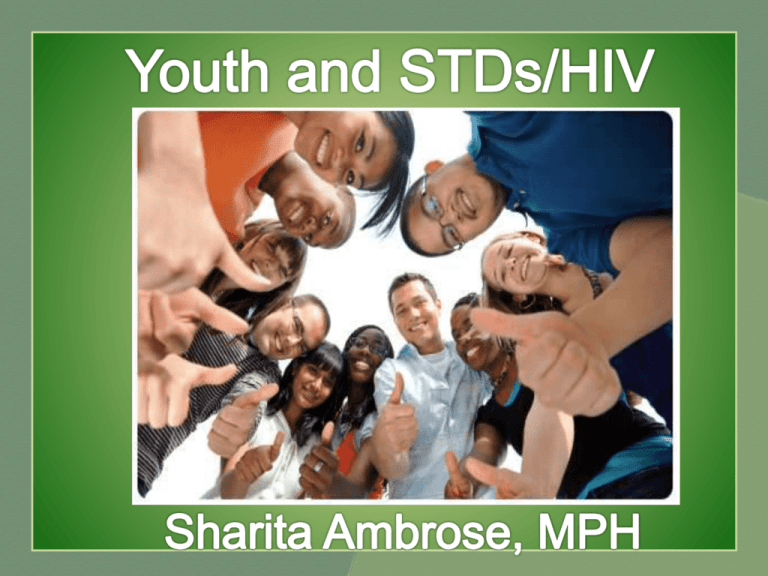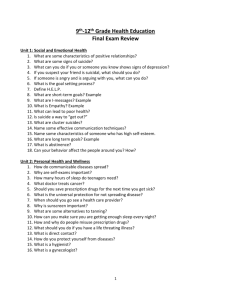
• Identify current HIV/STD facts about
youth 15-29
• Identify ways to harness the power of
youth in the fight against STDS/HIV
• Identify ways to address STD/HIV
among youth
Youth & STDs/HIV- The Facts
Youth & STDs/HIV- The Facts
• 39% of all new HIV cases are among young people ages 1329
• From 2007-2010, ages 15-19 and 20-24 were the only age
groups to experience an increase in the rate of diagnoses of
HIV infection.
• Youth of color and young men who have sex with men
continue to be most at risk.
• In Texas at the end of 2011 youth populations aged 15-29
reported 1743 new HIV infections
• In Texas the BIG 5 (Bexar Co., Dallas Co., Harris Co., Tarrant
Co., Travis Co.) comprise the largest number of youth
HIV/STD infections.
Harnessing the power of youth
Harnessing the power of youth
• Youth have access- use it
• Things go viral quickly
• Youth want to be a part of something
important.
• Get them involved in something largescale.
• Youth are out of the box thinkers
• Allow them to develop something that
reflects self expressions
Addressing the issue of HIV/STDs
Addressing the issue of HIV/STDs
• Keep talking
• Sex education/STD & pregnancy prevention needs to
become everyday conversation
• Think back to when you were a youth.
• Empathize with the life changes of being a young
person
• Encourage them to be honest
• Being able to be honest encourages that you will be the
“go-to person,” not ill-informed peers
• Never pass up a “teaching moment”
• Teach youth to analyze
Black or white, gay or straight, the face that most Americans
imagine when they think about HIV/AIDS
isn’t particularly wrinkled.
By 2015, more than half of all people living
with HIV in the US will be over 50.
It doesn’t matter how old you are: anyone can
become infected with HIV.
•
•
•
Thanks to advances in medical treatment, people are living
longer with the virus—in some cases more than 20 years (and
counting).
At the same time, older adults are rarely targeted in HIV
prevention campaigns and may not realize that their behaviors
can put them at risk for HIV infection.
As the population of older Americans at risk for—or living with—
HIV/AIDS grows, the daily realities and challenges of their lives
remain largely invisible in our youth-oriented culture.
We may not talk about it or see it in the
movies, but sex and romance continue to play
an important role in many people’s lives as
they age.
• Some who have lost a long-term romantic partner are starting
new intimate relationships for the first time since the HIV
epidemic began.
•
Some older adults have multiple partners or may be involved
with someone who is not monogamous.
The aging of HIV/AIDS reflects the merging of
two different populations.
•
Many older adults don’t know how to protect themselves
from HIV—or even know that they may be at risk.
•
Widespread availability of sexual enhancement drugs, like
Viagra, have made it possible for many men to be more
sexually active as they age.
“Ageism” describes a cluster of negative
attitudes about older people, including that
they are less sexual, less appealing, and
less competent.
•
Health care and social service providers, like everyone
else, sometimes make assumptions about people based on
personal prejudices that they may not be aware of.
This lack of attention to the prevention
needs of older adults is just one indicator of
the health care community’s collective
assumptions about who is and is not at risk
for HIV.
• Surrounded by asexual depictions of older people, many
providers don’t think to conduct thorough sexual and
substance use risk assessments when collecting medical
histories from patients over 50.
•
As a result, some of the possible indicators of HIV infection—
including muscle and joint pain, night sweats, and extreme
fatigue—may be written off as simply a part of “getting old.”
As the epidemic enters it’s fourth
decade…
•
Refocus some of our resources and efforts to address shifting
demographics
• Rethink our prevention education strategies to avoid new
infections
• Revise approaches to ensure early diagnosis and consistent
access to health care and social services



